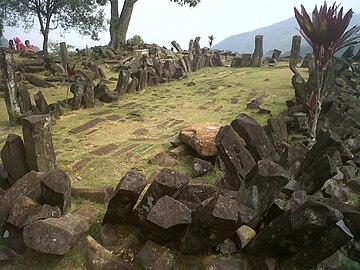Gunung Padang
This article needs additional citations for verification. (November 2015) |
Gunung Padang is a megalithic site located in Karyamukti, Campaka, Cianjur Regency, West Java, Indonesia, 30 kilometres (19 mi) southwest of the regency seat or 8 kilometres (5.0 mi) from Lampegan station. The site is built of earth and stone at the top of an extinct volcano. It has become famous due to controversial carbon dating results which, if they had been confirmed, would suggest that construction began as far back as 20,000 BCE.[1] In 2013 the geologist suggesting these dates, Danny Hilman Natawidjaja (often referred to only as Danny Hilman), suggested that the site had been built as a giant pyramid by the inhabitants of Atlantis around 11,000 BCE.[2]
In a 2014 Kompas.com report, archaeologist Harry Truman Simanjuntak suggests that the constructions may have been built much more recently, perhaps sometime between the 2nd and 6th centuries CE.[3]
History
The existence of the site was mentioned in Rapporten van de Oudheidkundige Dienst (ROD, "Report of the Department of Antiquities") in 1914. The Dutch historian N. J. Krom also mentioned it in 1949. Employees of the National Archeology Research Centre visited the site in 1979 for a study of its archaeology, history, and geology.[citation needed]
Located at 885 metres (2,904 ft) above sea level, the site covers a hill in a series of terraces bordered by retaining walls of stone that are accessed by about 400 successive andesite steps rising about 95 metres (312 ft). It is covered with massive rectangular stones of volcanic origin. The Sundanese people consider the site sacred and believe it was the result of King Siliwangi's attempt to build a palace in one night.
At the end of June 2014, the Education and Culture Ministry declared Gunung Padang site a National Site Area, covering a total of 29 hectares (72 acres).[4]
On 1 October 2014, surveyors halted excavation activities temporarily hoping to that they could begin them again under the new government.[5]
The 2014 excavation has been criticized for being improperly conducted.[6]
Criticism
Thirty-four Indonesian scientists signed a petition questioning the motives and methods of the Hilman-Arif team.[1] Vulcanologist Sutikno Bronto states that the site is the neck of an ancient volcano and not a man-made pyramid.[1] An archaeologist who did not wish to be named due to the involvement of the country's president who had set up a task force, said that: "In archaeology we usually find the 'culture' first … Then, after we find out the artefact's age we'll seek out historical references to any civilisation which existed around that period. Only then will we be able to explain the artefact historically. In this case, they 'found' something, carbon-dated it, then it looks like they created a civilisation around the period to explain their finding.".[1]
References
- ^ a b c d Bachelard, Michael (2013-07-27). Digging for the truth at controversial megalithic site. Sydney Morning Herald, 27 July 2013. Retrieved from http://www.smh.com.au/world/digging-for-the-truth-at-controversial-megalithic-site-20130726-2qphb.html.
- ^ Perez GarcÍa, Víctor Lluís (2017). "Gunung Padang y el megalitismo indo-malayo: Arqueología y pseudoarqueología" (PDF). Arqueoweb: Journal of Archeology on the Internet. 18 (1): 62–104. Retrieved 31 January 2022.
- ^ Utomo, Yunanto Wiji (2014-06-06). "Mari Terbang ke Atas Situs Megalitikum Gunung Padang".
- ^ "Balai Pengelolaan Situs Gunung Padang Segera Dibentuk". 2014-06-25.
- ^ "Timnas Gunung Padang Hentikan Penelitian". 2014-10-01.
- ^ Dipa, Arya (2014-09-24). "Archaeologists slam excavation of Gunung Padang site". thejakartapost.com.
External links
Coordinates: 6°59′36.5″S 107°03′22.96″E / 6.993472°S 107.0563778°E
- Articles with short description
- Short description with empty Wikidata description
- Articles needing additional references from November 2015
- All articles needing additional references
- All articles with unsourced statements
- Articles with unsourced statements from July 2019
- Commons category link is the pagename
- Coordinates not on Wikidata
- Megalithic monuments
- Archaeological sites in Indonesia
- Cianjur Regency
- Extinct volcanoes
- Archaeological controversies
- Pyramids in Indonesia
- Nationalism and archaeology

